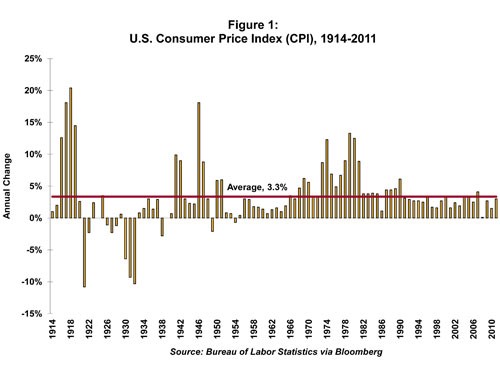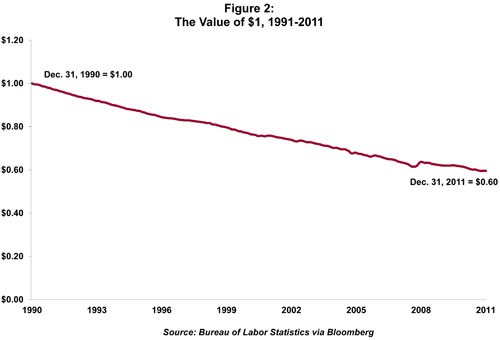Guarding Against Inflation US News
Post on: 7 Октябрь, 2015 No Comment

Protect yourself from this hidden threat.
Scott Holsopple
Your 401(k) investments have an enemy. Something is trying to eat away at your long-term savings, even as you see investing gains and push yourself to save and invest more.
What is this enemy to retirement planning? Inflation.
The definition of inflation is “a general increase in prices and fall in the purchasing value of money.” Bottom line: The same bag of groceries you buy at the store today will cost more when you buy it 10 years from now. Take, for example, a loaf of bread. The cost of a loaf of bread in the 1970s was around 36 cents. The average cost of a loaf of bread in 2012 is around $2.30. That’s inflation.
There’s been a lot said about inflation over the past few years, as the Federal Reserve works to keep interest rates low. Historically, inflation rates have been around three percent. Whether or not that number will jump significantly or hold steady is speculation. The important question to ask is how have you set yourself up to combat this inevitable financial occurrence.
It shouldn’t come as a surprise that the things you buy will cost more in the future. What does seem to come as a surprise to some investors is the need to set a strategy to outwit inflation’s ugly result. While chasing returns and investing in areas considered overly aggressive continue to be an issue with some investors, investing too conservatively is another way investors make mistakes in their accounts.
Investors hit hard with recent, and maybe not so recent, market drops sometimes believe the best course of action is to retreat to the safety of money market and savings accounts. While these accounts offer comfort away from the day-to-day tumultuous nature of stocks, they do not provide protection from the declining value brought on by inflation. If you’re making one percent in your savings account, which may be generous in this economic environment, then you won’t keep up with the rising cost of the goods and services you’ll need in the future.
Retirement investing is typically a long-term strategy. Creating a mix of investments that can provide both preservation and growth is the ultimate goal.
Historically, stock market investing has been a good way to beat inflation over the long haul. Retirement investors adjusting for inflation may consider including some inflationary hedges in their portfolio allocations. Consequently, an increasing number of 401(k) plans have added investing options designed to hedge against inflation. Two we’ve recently seen a focus on are real estate and TIPS.

Real estate values correlate with inflation, so these investments will often gain value as inflation heats up. In a 401(k) plan, look for real estate mutual funds and REITs (real estate investment trusts).
Treasury Inflation-Protected Securities, commonly known as TIPS, guarantee returns higher than inflation when held through their maturity, and many inflation-hedging bond funds include significant TIPS holdings.
Remember, choosing funds shouldn’t be haphazard. Each individual’s investing timeline, tolerance for risk, and investing preferences should play a primary role in creating a personalized asset class allocation. And not all investment options are good for everyone. Do your research and choose your portfolio based on your own needs and goals, not based on someone else’s needs.
If you’re trying to decide whether to update your allocation to hedge for inflation, a retirement adviser should be able to help you understand the nuances of your options.
Scott Holsopple is the president and CEO of Smart401k. offering easy-to-use, cost-effective 401(k) advice and solutions for the everyday investor. His advice has been featured on various news outlets, including FOX Business, USA Today and The Wall Street Journal.














